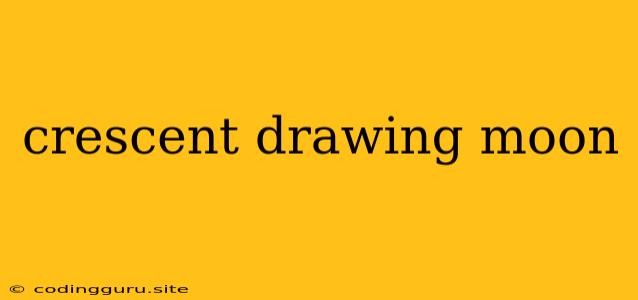Capturing the Beauty of a Crescent Moon: A Guide to Drawing
The crescent moon, a celestial symbol of beauty and mystery, has captivated artists for centuries. Its delicate, luminous form evokes a sense of peace and wonder. If you're interested in capturing this celestial beauty on paper, this guide will provide you with the essential steps and techniques to draw a stunning crescent moon.
Understanding the Shape and Light
The first step is to understand the unique shape of the crescent moon. It is a thin slice of the moon illuminated by the sun, creating a curve with a pointed tip and a darker, shadowed side. To draw it accurately, you'll need to consider the direction of the sun and how it casts light on the moon.
- Observing the Real Moon: One of the best ways to learn is to observe the crescent moon in the night sky. Note its shape, the angle of the curve, and the size of the illuminated part. You can even use a telescope to get a closer view of the moon's surface details.
- Reference Images: If the moon isn't visible, you can use reference images from online sources or photography books. Choose images that showcase the crescent moon in different phases and positions.
- Understanding the Phases: Familiarize yourself with the different lunar phases, such as the waxing crescent, waning crescent, and new moon. This will help you understand how the moon's shape changes over time.
Drawing the Crescent Moon: A Step-by-Step Guide
Materials:
- Paper: Use a smooth drawing paper, like Bristol board or sketch paper.
- Pencil: A sharp pencil, like a 2H or HB, will work well for sketching the initial outline.
- Eraser: A good eraser is essential for cleaning up mistakes and perfecting your drawing.
- Pen or Marker: A black pen or marker can be used to add definition to the outline and shade the moon's surface.
Steps:
-
Sketching the Outline: Start by drawing a simple curved line to represent the illuminated part of the crescent moon. Make the curve gentle and smooth, reflecting the moon's natural shape. The curved line should taper towards a point at the top, creating the crescent form.
-
Shading the Dark Side: Now, using a pencil or marker, shade in the dark side of the moon. Leave the illuminated part white or very lightly shaded to represent the reflection of sunlight.
-
Adding Detail: You can add further detail to your crescent moon drawing by including craters, mountains, or other surface features. To create these details, lightly shade in the areas you want to highlight and leave the surrounding areas blank.
-
Blending the Shades: For a more realistic look, use your finger or a blending stump to gently smudge the shaded areas. This will create a smooth transition between the light and dark sides of the moon.
-
Adding Atmosphere: To enhance the beauty of your crescent moon drawing, you can add a background of stars or clouds. Draw small dots for stars and use light, wispy lines to represent clouds.
Tips for Drawing a Realistic Crescent Moon
- Consider the Light Source: Remember that the crescent moon's shape is determined by the direction of the sun. If the sun is high in the sky, the crescent will be thin and narrow. If the sun is low on the horizon, the crescent will be thicker and more curved.
- Create Depth with Shading: Vary the pressure you apply with your pencil to create different shades of gray. This will add depth and dimension to your crescent moon drawing.
- Use a Reference Image: If you're struggling with the shape or shading, refer to a reference image for guidance. This will help you to achieve accuracy and realism in your drawing.
Examples of Crescent Moon Drawings
- Traditional Pen and Ink Drawing: This style uses black ink to create a detailed and intricate drawing of the crescent moon.
- Watercolor Painting: Watercolor can be used to create a soft and ethereal representation of the crescent moon.
- Digital Art: Digital art programs offer a wide range of tools and techniques for drawing a crescent moon.
Conclusion
Drawing a crescent moon can be a rewarding and fulfilling experience. By understanding the moon's shape, light, and phases, you can create stunning and realistic drawings that capture its beauty and mystery. Remember to practice, experiment with different techniques, and most importantly, have fun!
